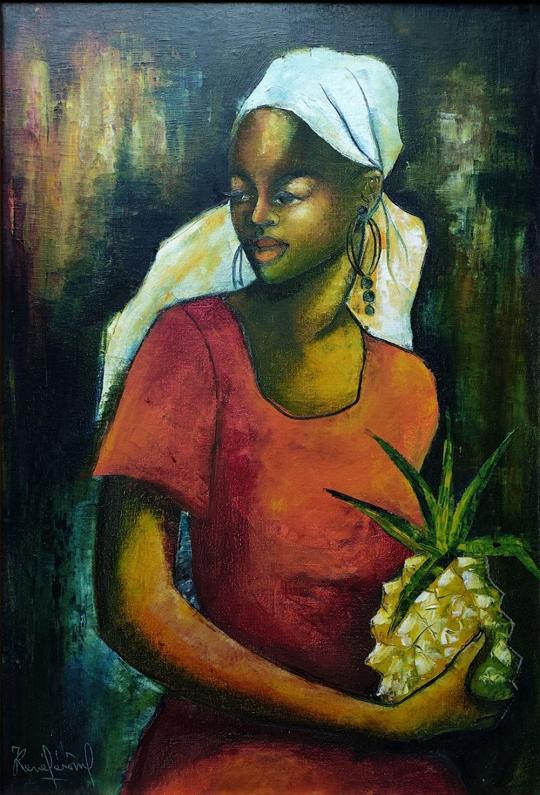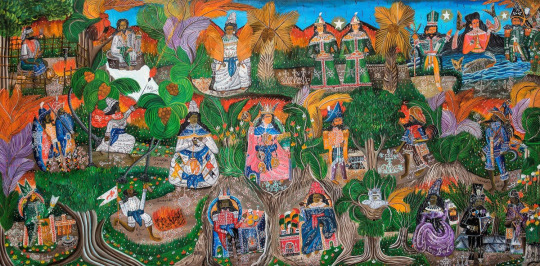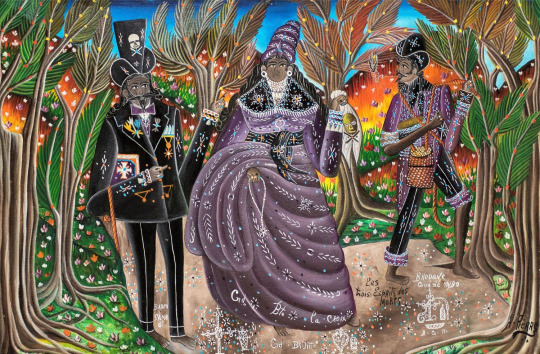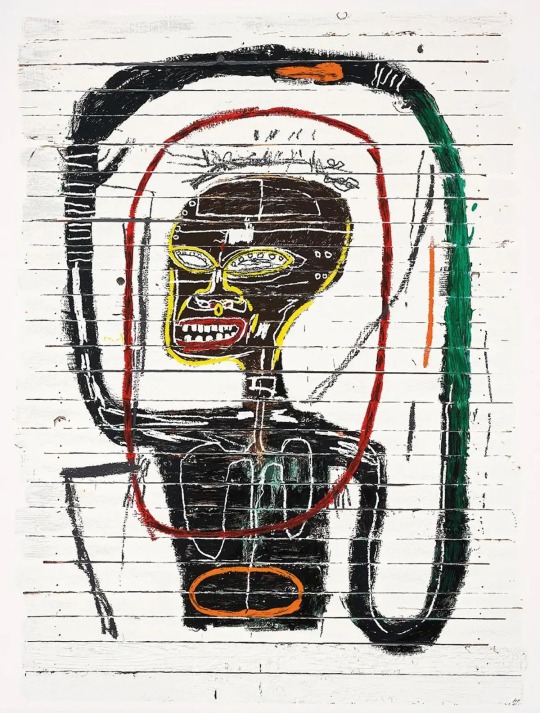#haitian painter
Explore tagged Tumblr posts
Photo

Jean-René Jérôme (1942–1991)
#jean rene jerome#black women#woc#haitian painter#haitian painters#jean-rené jérôme#caribbean painters#classic art
682 notes
·
View notes
Link
Felix Jean, the late and known Haitian primitive artist, painted this original 20"x16" painting circa 1970. It represents a vibrant and colorful street Rara scene in Haiti. The art is in good condition, belongs to a private collector in North Carolina, USA, and shipped from there. Felix Jean was born in Anse-a-Vau, Ha
5 notes
·
View notes
Text

Francois Cauvin, Sud
264 notes
·
View notes
Text

Jean-Michel Basquiat
Trumpet
1984
#jean michel basquiat#american painter#american artist#art history#samo#modern art#black artists#black painters#puerto rican artist#haitian artist#aesthetictumblr#american art#tumblraesthetic#tumblrpic#tumblrpictures#tumblr art#tumblrstyle#artists on tumblr#aesthetic#tumblrposts#trumpet#basquiat
84 notes
·
View notes
Text
Jean-Michel Basquiat was an influential American artist of Haitian and Puerto Rican descent. Basquiat first achieved fame as part of SAMO, an informal graffiti duo who wrote enigmatic epigrams in the cultural hotbed of the Lower East Side of Manhattan during the late 1970s, where rap, punk, and street art coalesced into early hip-hop music culture.
#BiArtists 🎨#Painter#Ilustrator#American#Bisexual#Haitian#PuertoRican#Artist#Art#BiArtists#Queer#LGBTHistory#BiHistory#basquait#jean michel basquiat#art history
6 notes
·
View notes
Text
“Art is a precious tool to nurture and reflect the complexities of our humanity, to create space for us to sit with it, deepening the understanding that we have of ourselves and the many connections that we have with each other,” - Manuel Mathieu
0 notes
Text

Team Haiti's opening ceremony uniforms for the 2024 Olympics, designed by Haitian-Italian designer Stella Jean.

The trousers and skirts are printed with 'Passage', an artwork by Haitian artist Philipe Dodard.
'...Stella Jean says she created uniforms on a humble budget for Team Haiti, one of the smallest delegations in the Olympics with just seven athletes...
...The look takes its white, red, and blue hues from the Haitian flag, with the men’s uniform consisting of a light blue jacket, an adaptation of the guayabera shirt worn by men in the Caribbean, vibrant trousers channeling Naïve folk art, and a Fular scarf. The women’s look features a skirt in the same material, paired with a light blue shirt and structured jacket with a cinched waist. Philippe Dodard, an acclaimed Haitian painter, designed the fabric for the trousers and skirt.
Wearing these uniforms at the Paris Olympics takes on an even deeper meaning for Haiti, once known as Saint-Domingue, a French colony that fought for its independence during the Haitian Revolution, the first successful resistance movement led by enslaved people against the French colonial regime from 1971 to 1804. “It’s hugely symbolic,” says Jean, who is Haitian-Italian, adding that she merged Haitian fabrics and motifs with Western silhouettes as “a tool of counter colonization.”
Jean ran into some issues as she worked to create her designs. Export embargoes in Haiti made sourcing chambray, a cotton-like material, for the women’s shirt difficult. “I used one of my dresses that my grandmother gave to me, because we were not able to source it otherwise. I hope she will forgive me because she's not here anymore,” Jean says, joking that her design unintentionally became more sustainable.
Throughout the process, she recognized the rare opportunity to present the world with a positive news story about Haiti, as the country struggles with a recent history of political violence, coups, and the deadly 2020 earthquake. Ongoing violence at the hands of armed gangs has displaced approximately 580,000 people, per U.N. figures.
“Haiti has no materials now. We have nothing to sell to the world. Our strength right now is this intangible richness [from] our deep culture,” Jean says. “We are here, we are joyful, and we will be back on our own two feet again.”...' Time Magazine
#stella jean#team haiti#paris olympics#olympics opening ceremony#haiti#haitian#uniforms#philipe dodard#pattern#surface pattern#surface pattern design#pattern design#textile design#textiles#fashion#print#printed textiles#time magazine#colonial history#colonization#french colonialism#colonialism#trade embargo#chambray
135 notes
·
View notes
Text
Boycott!

Now that I have your attention:
#free palestine#cartoon#cartoonist#israel is a terrorist state#free gaza#palestine#israel#gaza#palestina#hatsune miku#vocaloid#save the children#save family#back to school#deadpool#deadpool 3#deadpool and wolverine#gravity falls#billford#the book of bill#donate#donate if you can#please donate#gofundme#donations#fundraising#go fund them
27 notes
·
View notes
Photo

Gregory Mortenson Self-Portrait in Russian Hat
Gregory Mortenson (American, born in 1976) is a classical realist painter, known for his captivating portraits of Haitian children.
252 notes
·
View notes
Text

Servants Washing a Deer
Artist: Agostino Brunias (Italian, 1728 - 1796)
Object Type: Painting
Date: c. 1775
Medium: Oil on Canvas
Collection: Yale Center for British Art, New Haven, Connecticut
Agostino Brunias (c. 1730 – 2 April 1796) was an Italian painter who was primarily active in the West Indies. Born in Rome around 1730, Brunias spent his early career as a painter after graduating from the Accademia di San Luca. After he befriended prominent Scottish architect Robert Adam and accompanied him back to Britain, Brunias left for the British West Indies to continue his career in painting under the tutelage of Sir William Young. Although he was primarily commissioned to paint the various planter families and their plantations in the West Indies, he also painted several scenes featuring free people of colour and cultural life in the West Indies. Brunias spent most of his West Indian career on the island of Dominica, where he would die in 1796. Historians have made disparate assessments of Brunias's works; some praised his subversive depiction of West Indian culture, while others claimed it romanticised the harshness of plantation life. Haitian revolutionary Toussaint Louverture was a prominent admirer of his work.
7 notes
·
View notes
Text
Haiti and Mongolia ATE when it comes to their Olympics uniforms
instagram
I really want to Haiti's outfit made by an Haitian designer featuring the art of an Haitian painter. The outfits use karabela which is a traditional Haitian fabric. If you like the skirt in the pictures, you might want to look into karabela. I'm just so happy that my country is being represented so well <3 🇭🇹


instagram
8 notes
·
View notes
Photo

Jean-René Jérôme (1942 Petit Goave - 1991) "Woman with Pineapple", oil on canvas
#haitian painter#caribbean painters#black women#woc#jean rene jerome#haitian painters#oil painting#jean-rené jérôme#classic art
274 notes
·
View notes
Text

For Haitian Heritage Month, this is the first feature of Haitian artists who included Afrocentric folklore and/or spirituality in their works.
Woman with Flowers and Birds, 1948 by Hector Hyppolite, who was a self-taught painter and third-generation houngan. Other sources refer to it as “Maitresse Erzulie”.
Alt text: A painting of a nude, dark brown woman with a red band tied around her wavy, black hair. She is in side profile, standing, with her left hand raised, in the centre of a tree in which there are four plump, pink birds with black beaks and legs; two smaller greenish birds with yellow beaks and chests; a large, greenish parrot with a white beak and black legs; large, brown, winged insects; and flowers in different colours. [end of Alt text]
#Haitian Heritage Month#Caribbean art#Haiti#Caribbean#Latin America#Ayiti#art#painting#Alt text added#edited post
10 notes
·
View notes
Text


(Scrapped Concept) Maman la Vie
This is the last time I’m planning to draw this character, and her male counterpart, as they were both conceived in poor taste.
Lengthy explanation / rant below cut:
WHY THIS WAS A TERRIBLE CONCEPT FROM THE START
Long ago, I grossly mischaracterized the real-life Baron Samedi and Maman Brigitte like so:
…In the actual mythology Baron Samedi is like a womanizer who is cheating Maman Brigitte all the time. Maman Brigitte is also really promiscuous…
…In Voodoo, Maman Brigitte is portrayed as a white or light-skinned biracial woman because Maman Brigitte is the only one of the Loa that is European in origin, not African…
OOF! I CRINGE!!!
In all seriousness, the above is an incredibly offensive mischaracterization of the lwa.
Let’s start with Baron Samedi: I confused him with a different category of spirits, called “Gede”. The male Gede are known for being overtly sexual, but it is not because they are adulterous lechers. They celebrate sexuality because sexuality is the process by which life is created, for death is entwined with life. They also do this for the purpose of mocking social hierarchy - namely, the race/caste system that emerged out of chattel slavery. Zora Neale Hurston describes this at length in Tell My Horse. The reason why the Gede wear top hats actually pertains to this. The Gede are often portrayed as dark-skinned, for they are the spirits of enslaved people. Hence, the favorite spirit of the Black peasantry adopts the dress of the white slave-owning class - the top hat - for the purpose of mocking this social hierarchy. Their overt sexuality also serves this purpose - to alienate the white upper class.
My description of Maman Brigitte is yet more egregious. She is not promiscuous at all, nor is she Caucasian, biracial, or light-skinned.
Here is how the lwa are portrayed by the master painter, Andre Pierre:

Pierre portrays the lwa with a range of skin tones, where some of the lwa (e.g., Ezili Freda, Damballa Wedo) are portrayed as lighter skinned. Maman Brigitte is shown next to Baron Samedi in the bottom right corner.
Here is closer shot of Maman Brigitte, alongside Baron Samedi and Gede Nibo:

Maman Brigitte is portrayed as dark skinned, with the same skin tone as Baron Samedi and Gede Nibo. Additionally, she is not promiscuous, but a dignified and reserved older woman.
Andre Pierre is not the only Haitian artist to portray her in this manner. She is consistently portrayed this way by Haitian artists, such as Gerard Paul:
And Roudy Azor:
Eziaku Atuama Nwokocha describes Maman Brigitte (Gran Brijit) like so: “Gede, like all lwa, has many incarnations, including Bawon Samedi, a guardian of the cemetery; Gran Brijit, an old woman, keeper of the cemetery, and Gede’s partner; and Gede Nimbo, a male spirit who is often honored by queer people and who appears as an effeminate dandy.” (p. 37)
Elsewhere: “Gede’s delighted embrace of sexuality is an undeniable display of male desires. The spirit manifests in multiple genders, like his female counterpart Gran Brijit, but only the male version are so explicitly sexual. No female deity in the Vodou pantheon expresses sexual desires so emphatically or bluntly in a ceremony. There are female spirits who are coy, mysterious, vengeful, or wise, but not one proudly proclaims her sexual desires…” (p. 39-40)
Much like her male counterparts, there is a lot of nuance to the portrayal of Maman Brigitte’s sexuality (rather, lack thereof). This too pertains to the history of slavery and the manner in which racism is gendered: “During the centuries of enslavement in Hispaniola, enslaved Black women were subject to routine sexual abuse from White enslavers and others with the power to dominate them. To justify this commonplace brutality, Black women were constructed as hypersexual temptresses and prostitutes who were always available for sexual conquest...To combat the construction of Black women as hypersexual, their sexual desires were ignored entirely, characterized by reductive binaries that placed whores on one side and good, chaste Christian women on the other: there was no room for the actual desires of real women."
Source: Nwokocha, Eziaku Atuama. Vodou en vogue: fashioning Black divinities in Haiti and the United States. UNC Press Books, 2023.
Hence, my description of the lwa was incredibly offensive. I read it from a source that turned out to be not reputable. I apologize for being so careless in my research.
I do not know why the portrayal of Maman Brigitte as a White or Half White woman has persisted in the public consciousness. Surely, it is because it reinforces racist stereotypes of Black men and colorism against dark skinned Black women. But I think it is also because her name sounds so similar to the Celtic Saint. This does not mean that she is White. For example, the name “Baron Samedi” sounds European. If you didn’t know any better, you might think he is French, as “Samedi” is a French word. But the “Samedi” in “Baron Samedi” is distinctly non-European in origin. It is either derived from the indigenous term Zemi, or it is African in origin. Similar statements can be said to the lwa that arrived in New Orleans; Damballah became “Dani Blanc”, Ogou Feray became “Joe Feraille”, etc. Vodouisants were forced to Europeanize the names of these ancestral deities, who can trace their origins back to Africa. I remain uneducated about the true origins of Maman Brigitte, and it is something I have been meaning to research.
A while back, I spoke to a guy from Haiti on this topic. He got really ticked off and started talking about how terrible portrayals of Baron Samedi and Gran Brijit are. One of the main things he emphasized was how they play into fucked up, racist stereotypes of Black people. He got so pissed off I never got a chance to get to the root of the matter. Now that I’ve taken the time to research this more carefully, I realize just how horrendous the mischaracterizations are. Incredibly offensive descriptions are written in books, which turn into characters in various media that perpetuate these stereotypes. Just look at how common it is to see Baron Samedi portrayed as a lecher, and Maman Brigitte portrayed as a Caucasian or biracial woman! I didn’t fully grasp the gravity of what this man was trying to impress on me, until now. I completely underestimated the volume of misinformation that exists, and the appalling degree to which Vodou has been disrespected.
I really cannot stress this enough: The lwa are comparable to Catholic Saints. They are not these Satanic demons, and have only been mischaracterized as such due to the demonization of African religions that is rooted in the history of slavery. As far as I can tell, Baron Samedi really is one of the most misrepresented of the lwa; so is Maman Brigitte. Should they ever be put into Hazbin Hotel, I think it would be best to pay tribute to the great Haitian painters of the 20th century. To do otherwise is deeply disrespectful to people in New Orleans, Haiti, and other places in the diaspora. But perhaps this whole endeavor illustrates why it is a mistake to put either one of them into the show - that it does cross the line into cultural appropriation.
My depiction of the “Maman Brigitte”-type character and her male counterpart for sure crosses the line of cultural appropriation... It’s. SO. BAD!!!! I for sure deserve to get canceled for this one… Hence, I intend to correct this egregious error.
I might not have communicated this well in my previous post, but this is my intention: I have no plans to proceed with the old concept of “Maman la Vie” or “The Baron of Death”. This is the last time I plan to draw either one of them. I want to proceed with what I have been calling “the alternate concept” (i.e., “Baron of the Dead” and “Gran Maman”). I want to swap this “alternate concept” in, and move the old concept into a scrapped folder. If I had the time, I would for sure just go back, redraw old drawings, and delete the old concept. Unfortunately, I work full time, so I probably do not have time to do this. But the old concept bothers me so much, if I have time I will go back and fully redo this. In the meantime, my plans are to develop and proceed with the “alternate concept” (i.e., “Baron of the Dead” and “Gran Maman”). At minimum, I want to draw both of them at least once and refine their character descriptions. These would be moved into the main folder, replacing the old concept.
I hope that makes sense… it probably doesn’t…. Sorry, my brain is tired and communication is not my forte…my creative process is a hot mess and the inner machinations of my mind are an enigma…
ACTUAL IMAGE DESCRIPTION
I still drew her one last time because she is very fun to draw. I would be lying if I said I did not love this character on some level… Her personality is so outrageous, it is really funny to me. This tiny, under 5’ woman is the craziest sexual sadist in all of existence…!
In my brain, this makes so much sense. If you’re the immortal goddess of life who can heal any injury… your mind probably would go to that place, wouldn’t it…?
But yeah. This was totally conceived in poor taste…just, just start firing nukes at me!!! However, I love this character too much to completely scrap her, so instead I am going to reinvent her as a demon. A character with this personality clearly belongs in the setting of Hell. It’s so easy to just turn her into a demon, I don’t know why I didn’t think of this from the start.
That demon character is named “Lavi”. I guess these outfits would be outfits she might try on if she were to ever assume a human disguise… But she would probably only wear them briefly before stepping into a discount Harley D. Quinn fit.
The dress on the left is inspired by Nina Kristofferson as Billie Holiday. The dress on the right is inspired by a dress worn by Josephine Baker on May 5th 1953, when she appeared as Flower Girl at the Famous Charity Ball of the "Little white Beds" held at the Moulin Rouge, Paris. At that, I totally think someone in the cast of Hazbin Hotel has got to be styled after Josephine D. Baker herself - ideally, Alastor’s mother. I like that idea so much, I’m actually tempted to try to draw my take on canon Alastor’s mother…
#hazbin hotel oc#maman la vie (hazbin hotel)#she really is the discount harley quinn to end all discount harley quinns…#i dont even care. i love harley quinn so much!#but yeah… i’m not going to proceed with this character.#this is also bad character design because i just completely plagiarized that one other guy’s (girl?s) portrayal of the lwa#and made it so much worse… that’s one of my favorite portrayal of baron samedi and maman brigitte ever#they just look so fucking cool#in all seriousness i really apologize for this... part of this is because i thought of big papa first and everyone else was an afterthought
4 notes
·
View notes
Text

Jean-Michel Basquiat
Flexible
1982
#jean michel basquiat#basquait#flexible#american artists#american painter#black artists#puerto rican artist#haitian art#modern art#art history#aesthetictumblr#american art#tumblraesthetic#tumblrpic#tumblrpictures#tumblr art#tumblrstyle#artists on tumblr#aesthetic#tumblrposts#samo#painters on tumblr#painters
70 notes
·
View notes
Text
In 1981, Jean-Michel Basquiat sold his first painting titled, "Cadillac Moon". It was purchased by Debbie Harry
#BiArtists 🎨#Painter#Ilustrator#American#Bisexual#Haitian#PuertoRican#Artist#Art#BiArtists#Queer#LGBTHistory#BiHistory
0 notes